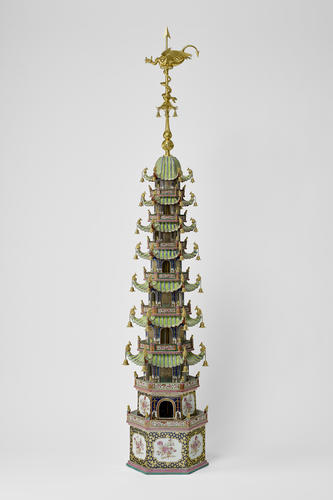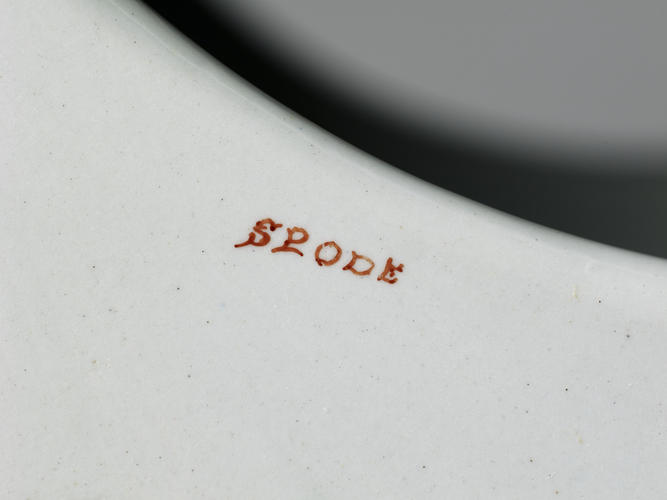Pair of small pagodas pagodas: c.1800-15, mounts: 1815-25
Porcelain painted in underglaze blue, famille rose enamels and gilt, and gilt metal | 192 x 42.5 x 36 cm (whole object) | RCIN 812
-
The pagoda with nine tiers, composed of seven hexagonal roofs of diminishing size with projecting curved roofs, the topmost being a high dome to which has been attached a tall, gilt-bronze finial passing through a gourd-shaped vase, a hexagonal canopy with pendent bells and a snake entwined arrow, piercing at the top a winged dragon. Although differing somewhat in their decoration, they have in this aspect been harmonised with the two larger sets, see RCIN 1 and RCIN 2400. The roofs are green-tiled with blue ridges and are painted with red undersides, terminating in upturned fish with pendent bells, both in gilt bronze. Each tier has three open doorways and three closed, again surrounded by blue canopies with gilt hangings; the penultimate tier, however, has one door only, all the other sides being enamelled with exotic blooms in panels, which are set in a darker blue ground with gilt over-decoration. Each tier is surrounded by an openwork balustrade, ornamented in this case with plants and birds, with a gilt-bronze lion inserted in each corner post. Like RCIN 1, the two lower tiers are constructed of rectangular panels of Spode pottery. On the base of RCIN 812.1 is the Spode mark overglaze in red terracotta.
Text adapted from Chinese and Japanese Works of Art in the Collection of Her Majesty The Queen: Volume II.
In eighteenth-century European art and architecture the pagoda was perhaps the most universal symbol of the Orient. Ivory and porcelain models were exported from China to the West, and William Chambers built a full-sized English version in the royal garden at Kew in 1762, based on his own first-hand study of Chinese architecture a dozen years earlier.
These two Chinese porcelain pagodas, together with another two pairs of a larger size, were part of the lavish decoration of the grand Music Room at Brighton Pavilion, which had been decorated by Frederick Crace under George IV's direct supervision.
The gilt-bronze mounts are English additions, commissioned to Benjamin Lewis Vulliamy.The Vulliamy family specialised in making and repairing clocks. From the 1790s, they produced bronze and gilt bronze objects of the highest quality. Often their role would be one of assembling parts made by different craftsmen, some of whom were directly employed by the family firm.Provenance
These are perhaps those bought in Paris for which François Benois submitted his bill in November 1815: ‘Deux pagodes de porcelaine du Japon’ (Royal Archives GEO/MAIN/26419). Benois’s purchases are evidently those inventoried in the Gallery at Brighton as ‘A pair of China Pagodas, in blue, red, green & gold, of sixteen pieces each, pierced enamelled galleries, ormolu Dolphins, Bells & Kylins at the angles, the two lower members having straight panelled sides of blue ground gold pateras & compartments of flowers, ormolu spear tops with flying Dragons, spiral snakes, Canopies Bells and Balls, painted wood bases, standing on Hexagon Mahogany pedestals having Chinese panels, eight feet ten inches [269.2 cm] high’ (1829B, p. 43). The gilt-bronze additions were very likely added in London, perhaps through robert Fogg.
Described in the Brighton Pavilion Inventory as 'A Pair in blue, red, green and gold, of sixteen pieces earch, pierced enamelled galleries, ormolu dolphins, Bells & Kylins at the angles, the two lower members having straight panelled sides of blue ground gold pateras & compartments of flowers, ormolu spear tops with flying dragons, spiral snakes, Canopies Bells and Balls, painted wood bases.' -
Creator(s)
(nationality)(metalworker)(ceramic manufacturer)Acquirer(s)
-
Medium and techniques
Porcelain painted in underglaze blue, famille rose enamels and gilt, and gilt metal
Measurements
192 x 42.5 x 36 cm (whole object)
Category
Object type(s)
Other number(s)
Place of Production
England












